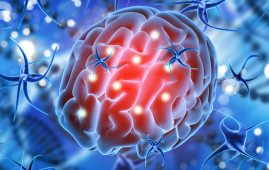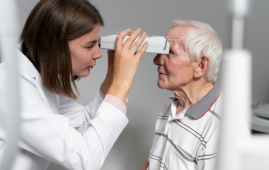

One of the chronic disorders with incapacitating pain and tiredness symptoms that are difficult to identify simply by looking at someone is fibromyalgia. The National Fibromyalgia Association estimates that it affects 10 million Americans, the majority of whom are women.
“We really do not understand the pathophysiology of fibromyalgia,” said Mohab Ibrahim, MD, PhD, associate director of medical affairs at the University of Arizona Health Sciences Comprehensive Pain and Addiction Center and professor of anesthesiology at the UArizona College of Medicine – Tucson. “There are some theories and hypotheses, and we are getting closer, but we are not there yet. So, because we don’t really understand why some people develop fibromyalgia and why others don’t, we try to manage the symptoms associated with it.”
Green light therapy is one of the cutting-edge techniques Ibrahim is looking into. It is risk-free, non-invasive, and has already produced fruitful outcomes in early clinical trials for those with fibromyalgia and chronic migraine.
Bedside to bench from there
The process of moving research from a laboratory setting to a clinical setting where it can help patients is frequently referred to as “from bench to bedside.” Ibrahim is in a unique position to enable his clinical practice drive his research from the bedside to the bench because he is a doctor and scientist.
“The way I designed my research is to answer questions I’m struggling with in the clinic. If I have a situation where it is very hard to manage a condition, that’s what I ended up researching in the lab to come up with solutions,” Ibrahim said. “That is one of the ways we came up with green light, because it was very hard to manage fibromyalgia and migraine.”
Ibrahim treats patients at the Banner – University Medical Center Chronic Pain Management Clinic in Tucson, Arizona, particularly individuals with fibromyalgia. His objective is to make each of his patients’ lives better without the usage of opioids, which have a number of detrimental side effects.
“We like to explore nonpharmacological methods first because they come with minimal side effects. One of the most common and effective first-line therapies to address fibromyalgia is aerobic exercises, where people might not necessarily do something intense, but they do enough to get their heart rate up and sweat a little bit,” Ibrahim said.
The use of over-the-counter NSAIDs, prescription painkillers like gabapentin, muscle relaxants, sleep aids, and mental care are examples of further treatments.
But occasionally, nothing is helpful.
Promising outcomes from pilot studies
In order to evaluate the efficacy of green light therapy, 21 fibromyalgia patients who had exhausted all conventional treatment options participated in a pilot clinical trial from 2016 to 2019. One white and one green LED light strip were provided to each study participant, together with instructions on how to use them: white for 10 weeks, then green for 10 weeks.
With the possibility to go up to two hours each day, participants were instructed to utilize the lights in a dark room with no other light source for at least one hour each day. They were urged to maintain their alertness—no sleeping!—and partake in non-light-dependent activities like writing, reading, or listening to music. The use of a smartphone or other activities that involved additional light sources, such watching television, were discouraged.
Throughout the trial, each participant completed surveys to record their feelings. The outcomes were astonishing.
“Their pain improved; their quality of life improved,” said Ibrahim, who was assisted in the research by Laurent Martin, PhD, who started in Ibrahim’s laboratory as a postdoctoral researcher and is now an assistant professor of anesthesiology in the College of Medicine – Tucson.
Specifically, while employing green light instead of white light, participants reported an average decrease in average pain intensity from 8.4 to 4.9 on the 10-point numeric pain scale. Participants also reported improvements in their ability to fall asleep and stay asleep, work, exercise, complete domestic duties, and generally live a better quality of life.
The outcomes were consistent with Ibrahim’s initial pilot clinical trial of green light therapy for persistent migraines. In that study, exposure to green light decreased the average number of headache days per month by roughly 60%. Participants reported that exposure to green light reduced their discomfort by 60%, from 8 to 3.2. Additionally, green light therapy reduced the length of headaches and helped individuals sleep better and stay asleep while doing their chores, exercising, and working.
Ibrahim finds the findings noteworthy in his capacity as a doctor and researcher.
“I wear two hats: scientist and physician. The scientist in me says this is a great finding, but this is where the story begins,” Ibrahim said. “I am really interested in how this works because if I understand the mechanism, then I can utilize it for other conditions. That’s the scientist part. The clinician in me thinks, this is really exciting! I have another tool in my toolbox to treat two of the most difficult conditions – migraine and fibromyalgia.”
He does, however, add a good dose of reality to balance his exuberance. There are still a lot of unanswered concerns regarding green light treatment, including how it functions. Ibrahim has already written papers that describe the physiological principles of using green light therapy to treat acute post-surgical pain. His lab is still researching the effects of bright light therapy on migraine or fibromyalgia-related chronic pain.
“Whenever someone asks me about green light therapy, I always say this is experimental,” Ibrahim said. “I like to put the brakes on a little bit, even on my own excitement, because I never want to give false hope. What I can tell you is that the preliminary data is very, very encouraging.
more recommended stories
 Brain Pulsations Linked to High BMI
Brain Pulsations Linked to High BMIAccording to a new study from.
 Brain Age Estimation: EEG Advancements in Neurology
Brain Age Estimation: EEG Advancements in NeurologyTo estimate brain age using EEG.
 Unlocking Ketogenic Diet for Epilepsy Management
Unlocking Ketogenic Diet for Epilepsy ManagementExploring the Therapeutic Potential of Ketogenic.
 Senescence in Neurons: Findings
Senescence in Neurons: FindingsBased on a new study by.
 Balanced Diet Linked to Enhanced Brain Health
Balanced Diet Linked to Enhanced Brain HealthDiet and brain health are strongly.
 Acid-Reducing Drugs Linked to Higher Migraine Risk
Acid-Reducing Drugs Linked to Higher Migraine RiskIndividuals who utilize acid-reducing drugs may.
 Atrial Fibrillation in Young Adults: Increased Heart Failure and Stroke Risk
Atrial Fibrillation in Young Adults: Increased Heart Failure and Stroke RiskIn a recent study published in.
 Neurodegeneration Linked to Fibrin in Brain Injury
Neurodegeneration Linked to Fibrin in Brain InjuryThe health results for the approximately.
 DELiVR: Advancing Brain Cell Mapping with AI and VR
DELiVR: Advancing Brain Cell Mapping with AI and VRDELiVR is a novel AI-based method.
 Retinal Neurodegeneration in Parkinson’s Disease
Retinal Neurodegeneration in Parkinson’s DiseaseBy measuring the thickness of the.

Leave a Comment